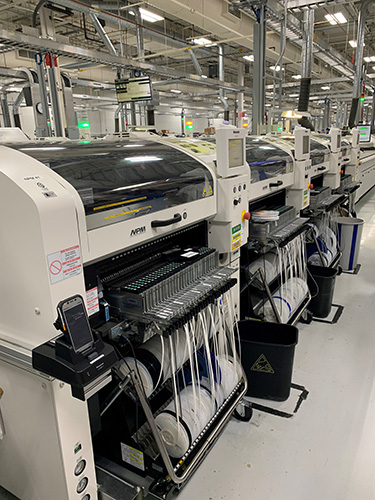To drive innovation and growth through the rest of 2024, hear from Panasonic Connect’s Gustavo Sepulveda for his recommendations.
By Gustavo Sepulveda, Robotics and Automation Business Head, Panasonic Connect North America
Between the impacts of COVID-19, volatile economic markets, and strained geopolitical situations over the past five years, manufacturers have been forced to identify weaknesses in their operations and quickly respond to find solutions to strengthen their business. While disruption has been a common theme throughout the past few years, 2024 can be a catalyst for success. That is, as long as manufacturing leaders prioritize growth and innovation throughout the rest of this year.
Over 68% of manufacturing executives feel positive about their own company’s outlook. But while feeling positive is an underlying descriptor for success, that percentage is the sixth straight reading below the National Association of Manufacturers historical average (74.8%). So, to creep back up towards a stronger outlook on the industry, manufacturers must do the following to see sustained success and balance: Take advantage of data and emerging technologies; be opportunistic with nearshoring; and invest in your most important asset – your people.
Manufacturers need to increase the implementation of automation and digital solutions throughout their factories as it can help solve some of their biggest challenges from how to maximize manual resources to enhancing production accuracy, quality, and efficiency. For example, implementing robots throughout the factory floor can drastically save time on tasks that previously required manual labor, something especially important as labor shortages persist. AI can help identify defects and anomalies in products during production, allowing plant managers to address issues before they reach customers, and machine learning algorithms can analyze sensor data from machines to predict when equipment will fail reducing any potential downtime within the line. AI and ML driven analytics can also help plant managers optimize their production processes. By analyzing data from machines and sensors, AI can identify where efficiencies can be improved whether optimizing production schedules or reducing material waste. Emerging technologies like these are helping unlock significant value across the factory floor and are transforming the industry’s once older and tedious reputation into that of a completely tech-forward industry.

According to a recent Deloitte survey of manufacturing executives, nearly 80% experienced an adverse supply chain in 2023, and almost half of all global supply chain executives expect to see more shocks throughout 2024 and 2025. How can you reduce potential pitfalls in the coming years? Nearshoring will have a great impact as it shortens supply chains and brings the manufacturer closer to its customer. Nearshoring is a long-term strategy that manufacturers can use to both reduce costs and avoid further supply chain setbacks due to potential geopolitical situations. Reshoring efforts can even drastically help revive North American manufacturing hubs with more jobs and economic impact. In fact, manufacturing-related construction spending hit a $210 billion annual rate in November, more than triple the average rate in the 2010s.
For North American manufacturers who have yet to establish roots back home, now is the time to do so. Reshoring even a few specific elements of a company’s manufacturing process can remove much of the uncertainty that comes with global supply chains. Reducing possible delays can be a difficult task to plan for, however, with the right solutions in place, companies can take preventative measures to ensure resilient factory and supply chain operations.
Despite 13 million people employed by more than 244,000 manufacturers in the U.S., there are still over 570,000 manufacturing job openings as of March 2024. And while many believe that technology’s sole purpose in manufacturing is to replace human labor, we must go deeper and think more critically about the relationship between technology and humans on the factory floor. While manufacturing is going through a continuous industrial revolution, it is critical to note that automation does not replace humans. But rather, manufacturers must look at what technology can do for its workers. While robots offer precision, humans provide critical and creative thinking to enhance the entire manufacturing process. Between new strategies to increase smart manufacturing solutions on the factory floor and diversifying where manufacturing operations are taking place, manufacturing leaders must look to how they can attract and maintain new talent to see success in the coming years.
Creating strong partnerships with schools is one great way to meet workforce needs by offering students hands-on experiences with the manufacturing technology they may encounter in their career. Sparking interest in the industry early on and offering that real-time experience before entering the workforce full-time is critical in creating a healthy pipeline of workers. And once employees enter the workforce? Both in-person and virtual training programs offered by technology partners and employers are key to keeping skills sharp and offering ample learning opportunities for those looking to grow into their next role. It’s also critical – and perhaps obvious – to offer your employees robust benefits. Table stakes packages that include fair wages and health insurance are critical, but manufacturers should also address employee turnover with things like loyalty bonuses and clear promotion pathways. Through education partnerships, training programs, and ample benefits packages, it is possible to maintain your workforce.
Manufacturers have learned a lot over the past few years, and 2024 is likely to bring forward a new set of challenges as recessions loom overhead and elections quickly near. So, at the midway point of the year, right now is a great opportunity to look at these key pillars and see where you can do better. From assessing your technology stack and increasing smart manufacturing capabilities, to seeking new areas of operation and rethinking your approach to people operations – finish out the year as strong as possible and continue to push the needle forward.

Gustavo Sepulveda is the robotics and automation business head at Panasonic Connect. Gustavo leads a team that delivers automation solutions to the electronics and metal fabrication industries. He works with manufacturing customers to navigate their ever-changing and challenging environment. Gustavo is a passionate leader and mentor who is dedicated to shaping the next generation of workers.
Scott Ellyson, CEO of East West Manufacturing, brings decades of global manufacturing and supply chain leadership to the conversation. In this episode, he shares practical insights on scaling operations, navigating complexity, and building resilient manufacturing networks in an increasingly connected world.